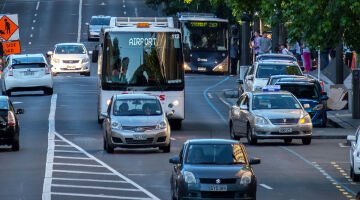Fears of infection have seen shared mobility and public transport patronage plummet, with some studies saying public transport patronage won’t come back beyond 80% of pre-Covid levels.
Suburban shopping is resurgent with fewer people commuting to office jobs and purchase of second hand cars on the rise. Car fleet sales continue to increase, drivers licences for those 40+ are growing, and in at least one Australian city car travel growth has exceeded public transport growth.
All of which is why the pro public transport and active travel cabals call to reduce the ‘parking footprint’ - especially on-street – is so perplexing. Especially so when many of the car critics are now calling on other jurisdictions to follow the ACT Government’s lead and subsidise electric vehicle adoption.
Moreover, academics regularly publish articles on The Conversation about cars dominating cities, the need to design cities around people, reduce the parking footprint, increase funding for public transport, pedestrianise streets and scrap parking minimums for developments to improve affordable housing and reduce driving.
Anti-car virtue signaling is all well and good until you realise driving is what most people want to do. A point summed up by researcher, economist and strategic thinker Dr Cameron Gordon, “Many academics generally don’t consider the added practicality of on-street parking and the empirical fact that most people still want and need to drive to meet the requirements of daily life, at least under current conditions.”
Don’t get me wrong, there are compelling air quality and climate change reasons to lower car vehicles kilometres travelled – due to what comes out the tail pipe of an internal combustion engine – especially over the short to medium term, with car use currently accounting for approximately three quarters of transport emissions. Over the longer term, the electrification of travel and particularly the adoption of electric vehicle cars will drive road and parking bay use.
Not only is seeking to reduce on-street parking and car use out of step with the current pandemic and longer term EV aspirations, it raises the question, “where are all the EVs going to park?”
A portfolio of options
Governments like options. So why limit them to ‘mode shift’ to public transport and active travel when transport planning?
Dr Gordon takes a realist and broad based approach to delivering the daily transport task in a world getting hit by so many megatrends, “Climate crisis, urban suburban sprawl, public health crisis, the car has been seen as the main cause of these phenomena and its limitation - for some, elimination - has been seen as one important solution to them. The main problem with this view is that active travel and public transport are not going to get there and replace all the passenger kilometres travelled in Australia’s low density cities. We are not Copenhagen.”
“Standard solutions like public transport have their own problems, such as the gentrification of PT corridors driving up housing costs. Then there are the economics of public transport with light rail versus trackless trams for example. Whatever we do the point is to increase capacity and not take it away, like what we did here in Canberra reducing the bus service along the light rail route. The two modes are complementary and should be integrated with each other and the broader transport task that the public needs to get done.”
I am the hunter
But’s let’s jump on to the demand side of the equation, design the city for the people and ask the people what they would do if we reduced on-street parking. A survey recently conducted by the city of Wellington (NZ) asked that exact question, and illustrates the three challenges and opportunities facing planners, with respondents providing one of three answers:
- Same again - approximately one in three drivers will keep circling around the block hunting for an on-street park
- Off we go - another third said they will park off-street, and
- Innovators and change agents - the rest were open to a mixture of mode shift to PT and active travel.

As Dr Gordon mentions, we can deploy smart technology to help drivers find on-street parking faster – that’s been proven most recently in Rye, Victoria – where it was estimated that real time parking availability data saved over 1,700 hours of driver time over the busy summer period. That means more time in zone for spending, happier rate payers, visitors and shop owners as they found parking quicker.
The second point is a little harder, as it raises a key question of how we can better direct drivers to the off-street carparks, who controls the parking assets, how can we publish the real time data and how can we persuade people to change behaviour? A parking mode shift of sorts.
Enter Public / Private Partnerships (PPP) with off-street providers.
Many councils and cities are minority players in the total parking supply - e.g. ACT Government where two thirds of the supply is provided privately or by a federal government authority - or have few off-street options to direct drivers to like in busy seaside town of Cronulla, NSW. Some like Bendigo council are fortunate in that they own close to 90% of the parking and have control over the product and the messaging – ‘park a little later and walk a little further’.
What’s needed here is a massive collaboration piece to bring privately run off-street parking into the smart city transport plan, as the private sector tends not to think at a city level; even if there’s a compelling reason such as reducing congestion and emissions. That’s the job for government – to lead and help set the vision.
But here’s the problem with taking away on-street parking and redirecting drivers to off-streets
Even if the decision has been made to reduce on-street parking, introduce parklets and share spaces to support distancing and retail and help people connect, and promote parking in gold plated off-street parking, planners are likely to face the following:
- The demand side thing – see above survey by Wellington City council (NZ). There’s workers, shoppers, and hospitality goers and they need different types of transport and short or long term parking and behave differently e.g. if you are eating and drinking you are more likely to overstay parking controls, denying the next person access. Then there are driver profiles within each group, the ‘river boat gambler’ who is prepare to pay anything to park out the front, versus the ‘low confidence’ first time shopper who doesn’t know the area and visits irregularly, and the take-away parker still needs on-street parking.
- Money talks - pre-Covid Australia had some of the most expensive off-street private car parks in the world according to the 2019 Parkopedia report and the OECD reports we have the second highest household indebtedness. Added to that is the economic tsunami that has swept through the nation means disposable income has taken a further hit. While the Parkopedia report has its critics, it showed that on-street parking is cheaper than off-street in many instances (outside of Sydney) – hardly an incentive to get off the streets to park.
- Non eatery/bar retail will move out. This happened in Canberra, when aspirational parking meant customers just couldn’t find a park at the Kingston Foreshore. In Braddon businesses simply moved out to Fyshwick. Classic forced regulatory reform is very 1990s and has no place in a world where trust between citizens and government is close to an all time low. Real engagement, citizen panels and business support are cornerstones here of any good process and sustainable service.
Where’s the digital economy when you need it?
What we now call the smart city is unerringly similar to what we also called the digital economy, whose two core tenets, at the risk of oversimplification, are using digital to impact a network of economic and social activities to deliver:
- Greater efficiencies in current state services and activities; and
- Transformational change and delivering new value
Multiple reports show that those businesses and organisations that use digital grow faster, earn more and employ more people, delivering better outcomes. But as Dr Gordon cautions, “Technology can be a good or dirty word, depending on who is using it and how it is being used. But in fact everything depends on the social design and implementation of it. Cars are just another technology that can be used to accomplish both of the goals above – and other desired social ends. One leaves them out of the portfolio at one’s peril.”
Ignoring the ‘last mile’ is akin to the federal government’s suboptimal NBN solution, which failed to apply technology to upgrade the last mile copper connectivity to the household; halving speeds and annoying customers.
And just like the NBN, who has to now ‘mow the lawn’ and go back over the NBN solution to try sort out these issues, our failing to sensor up parking on and off-street offerings is costing us time and money – millions in the cost of lost driver time, reduced retail revenues, lower financial returns and harm done to the environment through emission reduction forgone.
Let’s talk solutions
So to flip the narrative - how do we help solve car travel's last mile?
“What we should be focusing on are a portfolio of options, things like reducing travel times by optimizing the last mile of the trip, such as street signage and apps showing the best place to park and how to avoid the 6 minutes of hunt time wasted looking for a park,” says Dr Gordon.
This is where traffic data and parking as a service provides the sound evidence for policy making and planning. Origin and destination data for road use across Sydney estimates that the last 20% of the trip takes up to 50% of the time; aka the hunt time to find a park. Providers like Intelematics, Live Traffic data, and technology including blue tooth sniffers showing point to point travel times are part of the solution; but it’s the integration of traffic and parking availability and payments data that is key to ensure an end to end data driven solution for planners, retail and drivers:
- Smart Parking - Real time parking guidance to an available bay has been proven to shave 10% off the average 20 minute commute, reducing actual and perceived congestion (measured in time saved), effectively taking cars hundreds of cars off the road by reducing car emissions. Not impressed? Then how about stop talking down to citizens and start valuing driver time and translating that into retail spending for your cost benefit analysis – not everything is about the financial return to government, it should be about the driver first and foremost (see reference to low trust in government). And it works. The Rye evaluation found that real time parking availability data reduced hunting time down from 4.14 to 1.41 minutes on average, while mitigating overstays had the potential to boost retail spending by up to $4078 per day on main streets.
- What’s happening, why and predict it - as transport data scientist Dr Gary Au advises, to deliver all the benefits of smart parking you need to manage down overstays – the key blockers to fairer and optimised access. All the benefits hang off the ability to reduce people camping out in high demand parking bays, especially at peak hour near eateries and hospitality (not to mention hospitals). To do that you need real time and predictive enforcement, based on sensors or cameras, or a combination of both, and cover not just paid but all timed parking, short and long term, on and off-street.
- Change management – using the ADKAR model to get attention, desire, impart knowledge and get repeatable actions from day 1 has been found to be the missing piece of the impact puzzle. Smaller scale smart parking trials suffer from a lack of ‘pull through’ placing a premium on councils and vendors early and often engagement with drivers and retail. Leveraging retail stakeholders and then incentivising behaviour change to get people to go to the off-street carparks (lower pricing) can help deliver impact at scale, but we need to rethink how we do ongoing engagement and promotion, embedding resources in smart transport projects to get the required usage.
- Total parking beyond the street curb – the vision should be public private partnerships between councils, public and private private carparks, supermarkets and shopping malls, hospitals (most people travel by car to hospital in Victoria), leisure centres, education facilities etc - involving data sharing and publication of availability, pricing, usage and overstays on as many platforms as possible. Why limit yourself to one? That would be communism. Sharing or selling access to openAPIs to enable a ‘total parking’ city app that covers on and off-street, public and private has the potential to provide the full information that drives choice and impact at scale. It defines not just innovation but scale to impact. Otherwise we are playing at the fringes and falling head long into the dreaded silo’d approach, as we gain purchase and build through success ‘one project at a time’.
- Sensoring up EV Charge points – the UK has started providing real time and predictive parking availability for charge points and its something that needs to be built out here right now. Hardware manufacturers have predictive maintenance, so its not a stretch to extend that to availability and then to enable sensor based enforcement to ‘de-ICE’ bays.

Conclusions
Which brings us back to EVs.
The UK just banned heavy polluting vehicles car sales by 2030. As Australia is one of the dirtiest car fuel nations on earth, this is not some that is likely to be ushered in here anytime soon. But once it comes, the end of the ‘ICE mobile’ will really just be the beginning of the electric vehicle – with 50% of Australia say they are keen for their next car to be electric (the author one of them).
And like any adoption curve, price points have to come down before you hit the flat line of high growth. The challenge is to be ready when EV growth flat lines so that we can optimise demand – especially at public charging, where the UK already experiencing ‘charge rage’ and charge points being taken out.
If we can bring the car travel and parking back front and centre into the transport discussion then we will stand the best chance of solving the wicked problem of getting from A to B to C and back to A, pandemic or no pandemic; ICE car or EV, working, commuting, shopping or socialising it will mean people have greater choice and real time information and help realise the efficiency and transformative benefits on offer from a democratic and smart city.


 ANPR Camera System
ANPR Camera System SmartCloud Hub
SmartCloud Hub SmartCloud Platform
SmartCloud Platform Compliance Management System
Compliance Management System Pay & Walk
Pay & Walk Mobile Patrols
Mobile Patrols Vehicle Detection Sensors
Vehicle Detection Sensors




